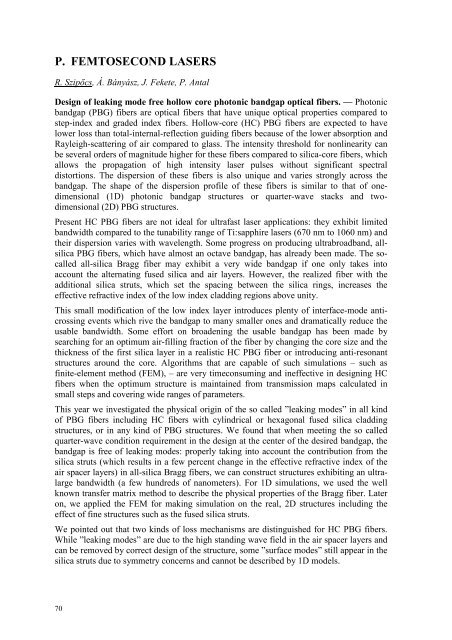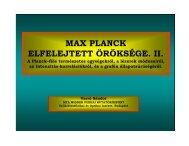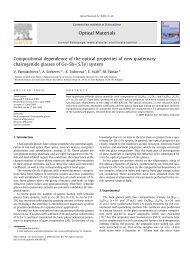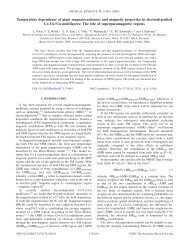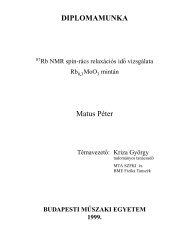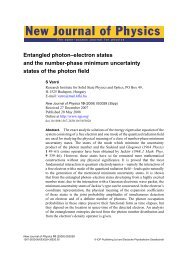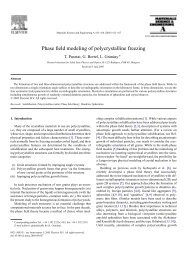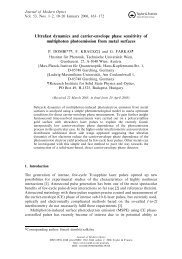ANNUAL REPORT - MTA SzFKI
ANNUAL REPORT - MTA SzFKI
ANNUAL REPORT - MTA SzFKI
You also want an ePaper? Increase the reach of your titles
YUMPU automatically turns print PDFs into web optimized ePapers that Google loves.
P. FEMTOSECOND LASERS<br />
R. Szipőcs, Á. Bányász, J. Fekete, P. Antal<br />
Design of leaking mode free hollow core photonic bandgap optical fibers. — Photonic<br />
bandgap (PBG) fibers are optical fibers that have unique optical properties compared to<br />
step-index and graded index fibers. Hollow-core (HC) PBG fibers are expected to have<br />
lower loss than total-internal-reflection guiding fibers because of the lower absorption and<br />
Rayleigh-scattering of air compared to glass. The intensity threshold for nonlinearity can<br />
be several orders of magnitude higher for these fibers compared to silica-core fibers, which<br />
allows the propagation of high intensity laser pulses without significant spectral<br />
distortions. The dispersion of these fibers is also unique and varies strongly across the<br />
bandgap. The shape of the dispersion profile of these fibers is similar to that of onedimensional<br />
(1D) photonic bandgap structures or quarter-wave stacks and twodimensional<br />
(2D) PBG structures.<br />
Present HC PBG fibers are not ideal for ultrafast laser applications: they exhibit limited<br />
bandwidth compared to the tunability range of Ti:sapphire lasers (670 nm to 1060 nm) and<br />
their dispersion varies with wavelength. Some progress on producing ultrabroadband, allsilica<br />
PBG fibers, which have almost an octave bandgap, has already been made. The socalled<br />
all-silica Bragg fiber may exhibit a very wide bandgap if one only takes into<br />
account the alternating fused silica and air layers. However, the realized fiber with the<br />
additional silica struts, which set the spacing between the silica rings, increases the<br />
effective refractive index of the low index cladding regions above unity.<br />
This small modification of the low index layer introduces plenty of interface-mode anticrossing<br />
events which rive the bandgap to many smaller ones and dramatically reduce the<br />
usable bandwidth. Some effort on broadening the usable bandgap has been made by<br />
searching for an optimum air-filling fraction of the fiber by changing the core size and the<br />
thickness of the first silica layer in a realistic HC PBG fiber or introducing anti-resonant<br />
structures around the core. Algorithms that are capable of such simulations – such as<br />
finite-element method (FEM), – are very timeconsuming and ineffective in designing HC<br />
fibers when the optimum structure is maintained from transmission maps calculated in<br />
small steps and covering wide ranges of parameters.<br />
This year we investigated the physical origin of the so called ”leaking modes” in all kind<br />
of PBG fibers including HC fibers with cylindrical or hexagonal fused silica cladding<br />
structures, or in any kind of PBG structures. We found that when meeting the so called<br />
quarter-wave condition requirement in the design at the center of the desired bandgap, the<br />
bandgap is free of leaking modes: properly taking into account the contribution from the<br />
silica struts (which results in a few percent change in the effective refractive index of the<br />
air spacer layers) in all-silica Bragg fibers, we can construct structures exhibiting an ultralarge<br />
bandwidth (a few hundreds of nanometers). For 1D simulations, we used the well<br />
known transfer matrix method to describe the physical properties of the Bragg fiber. Later<br />
on, we applied the FEM for making simulation on the real, 2D structures including the<br />
effect of fine structures such as the fused silica struts.<br />
We pointed out that two kinds of loss mechanisms are distinguished for HC PBG fibers.<br />
While ”leaking modes” are due to the high standing wave field in the air spacer layers and<br />
can be removed by correct design of the structure, some ”surface modes” still appear in the<br />
silica struts due to symmetry concerns and cannot be described by 1D models.<br />
70


